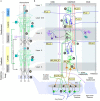Remembrance of things perceived: Adding thalamocortical function to artificial neural networks
- PMID: 36959924
- PMCID: PMC10027940
- DOI: 10.3389/fnint.2023.1108271
Remembrance of things perceived: Adding thalamocortical function to artificial neural networks
Abstract
Recent research has illuminated the complexity and importance of the thalamocortical system but it has been difficult to identify what computational functions it performs. Meanwhile, deep-learning artificial neural networks (ANNs) based on bio-inspired models of purely cortical circuits have achieved surprising success solving sophisticated cognitive problems associated historically with human intelligence. Nevertheless, the limitations and shortcomings of artificial intelligence (AI) based on such ANNs are becoming increasingly clear. This review considers how the addition of thalamocortical connectivity and its putative functions related to cortical attention might address some of those shortcomings. Such bio-inspired models are now providing both testable theories of biological cognition and improved AI technology, much of which is happening outside the usual academic venues.
Keywords: attention; illusion; learning; memory; saliency; thalamus.
Copyright © 2023 Loeb.
Conflict of interest statement
The authors declare that the research was conducted in the absence of any commercial or financial relationships that could be construed as a potential conflict of interest.
Figures


Similar articles
-
Memristors for Neuromorphic Circuits and Artificial Intelligence Applications.Materials (Basel). 2020 Feb 20;13(4):938. doi: 10.3390/ma13040938. Materials (Basel). 2020. PMID: 32093164 Free PMC article.
-
Development of thalamocortical connectivity during infancy and its cognitive correlations.J Neurosci. 2014 Jul 2;34(27):9067-75. doi: 10.1523/JNEUROSCI.0796-14.2014. J Neurosci. 2014. PMID: 24990927 Free PMC article.
-
Natural and Artificial Intelligence: A brief introduction to the interplay between AI and neuroscience research.Neural Netw. 2021 Dec;144:603-613. doi: 10.1016/j.neunet.2021.09.018. Epub 2021 Sep 28. Neural Netw. 2021. PMID: 34649035
-
Advancements in Microprocessor Architecture for Ubiquitous AI-An Overview on History, Evolution, and Upcoming Challenges in AI Implementation.Micromachines (Basel). 2021 Jun 6;12(6):665. doi: 10.3390/mi12060665. Micromachines (Basel). 2021. PMID: 34204065 Free PMC article. Review.
-
[Artificial neural networks as a psychiatric instrument].Tijdschr Psychiatr. 2023;65(10):646-650. Tijdschr Psychiatr. 2023. PMID: 38174402 Review. Dutch.
References
-
- Baars B. J. (2007). “The global workspace theory of consciousness,” in The Blackwell Companion to Consciousness, eds Velmans M., Schneider S. (Hoboken, NJ: John Wiley & Sons, Ltd.), 236–246. 10.1002/9781119132363.ch16 - DOI
Publication types
LinkOut - more resources
Full Text Sources

